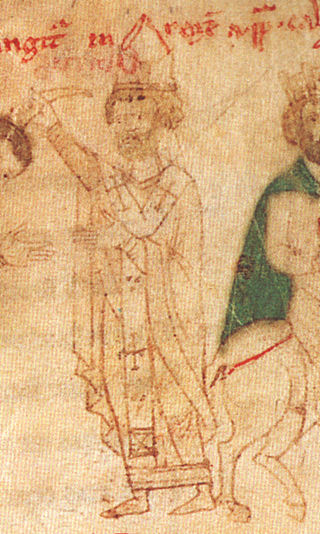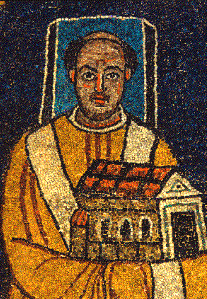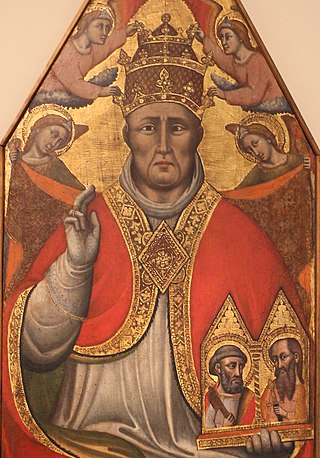Related Research Articles

Pope Callixtus II or Callistus II, born Guy of Burgundy, was head of the Catholic Church and ruler of the Papal States from 1 February 1119 to his death in 1124. His pontificate was shaped by the Investiture Controversy, which he was able to settle through the Concordat of Worms in 1122.

Pope Sergius I was the bishop of Rome from 15 December 687 to his death, and is revered as a saint by the Roman Catholic Church. He was elected at a time when two rivals, Paschal and Theodore, were locked in dispute about which of them should become pope. His papacy was dominated by his response to the Quinisext Council, the canons of which he steadfastly refused to accept. Thereupon Emperor Justinian II ordered Sergius' arrest, but the Roman people and the Italian militia of the exarch of Ravenna refused to allow the exarch to bring Sergius to Constantinople.

Pope Paschal I was the bishop of Rome and ruler of the Papal States from 25 January 817 to his death in 824.
Pope Paschal II, born Ranierius, was head of the Catholic Church and ruler of the Papal States from 13 August 1099 to his death in 1118. A monk of the Abbey of Cluny, he was created the cardinal-priest of San Clemente by Pope Gregory VII (1073–85) in 1073. He was consecrated as pope in succession to Pope Urban II (1088–99) on 19 August 1099. His reign of almost twenty years was exceptionally long for a medieval pope.
Antipope Paschal III was a 12th-century clergyman who, from 1164 to 1168, was the second antipope to challenge the reign of Pope Alexander III. He had previously served as Cardinal of St. Maria.
Paschal is used as a name. Paschal, a variant of Pascal, from Latin Paschalis, is an adjective describing either the Easter or Passover holidays.

The Paschal mystery is one of the central concepts of Catholic faith relating to the history of salvation. According to the Compendium of the Catechism of the Catholic Church, "The Paschal Mystery of Jesus, which comprises his passion, death, resurrection, and glorification, stands at the center of the Christian faith because God's saving plan was accomplished once for all by the redemptive death of himself as Jesus Christ." The Catechism states that in the liturgy of the Church "it is principally his own Paschal mystery that Christ signifies and makes present."

The Roman Catholic Archdiocese of Manfredonia–Vieste–San Giovanni Rotondo is a Latin Catholic non-Metropolitan Archdiocese in the civil province of Foggia, in Apulia, south-eastern Italy, which is part the ecclesiastical province of the Metropolitan Archdiocese of Foggia-Bovino

The Paschal trikirion is a liturgical triple-candlestick used at Easter time in the Eastern Orthodox and Byzantine Catholic traditions.

The Diocese of Frascati is a suburbicarian see of the Holy Roman Church and a diocese of the Catholic Church in Italy, based at Frascati, near Rome. The bishop of Frascati is a Cardinal Bishop; from the Latin name of the area, the bishop has also been called Bishop of Tusculum. Tusculum was destroyed in 1191. The bishopric moved from Tusculum to Frascati, a nearby town which is first mentioned in the pontificate of Pope Leo IV. Until 1962, the Cardinal-Bishop was concurrently the diocesan bishop of the see in addition to any curial duties he possessed. Pope John XXIII removed the Cardinal Bishops from any actual responsibility in their suburbicarian dioceses, and made the title purely honorific.
Events from the 1360s in England.

John Barnet was a Bishop of Worcester then Bishop of Bath and Wells then finally Bishop of Ely.
John of Oxford was a medieval Bishop of Norwich.
Thomas Trilleck was a medieval Bishop of Rochester.

The Diocese of Vieste was a Roman Catholic diocese located in the town in the province of Foggia, in the Apulia region of southeast Italy. On 27 June 1818, the diocese of Viesti was granted to the archbishops of Siponto (Manfredonia) as perpetual Administrators. On 30 September 1986, the diocese of Viesti was suppressed, its territory incorporated into the archdiocese of Siponto, and renamed the Archdiocese of Manfredonia–Vieste. Its former cathedral, named in honor of the Assumption of the body of the Virgin Mary into heaven, is now the Vieste Co-cathedral and, like nearly all cathedrals in Italy, a minor basilica.
William de Cambuslang was a 14th-century Scottish churchman, presumably coming from a family based at or originating from Cambuslang near Glasgow.

The 1362 papal conclave elected William Grimoard as Pope Urban V to succeed Pope Innocent VI in the Palais des Papes of Avignon, continuing the Avignon Papacy.
Adam Houghton, also known as Adam de Houghton, was Bishop of St David's from 1361 until his death and Lord Chancellor of England from 1377 to 1378.
Thomas Fastolf, sometimes spelt Fastolfe, was an English canon lawyer and Bishop of St David's from 1352 until his death.

The 1099 papal election following the death of Pope Urban II took place on 13 August 1099. Before his death, Urban had designated Cardinal Rainerius da Bieda as his successor. The cardinal-electors, with the consent of the lower Roman clergy, chose Rainerius, who, after a flight and over his considerable objections, accepted and took the name Paschal II. He was consecrated a bishop and crowned pope on the next day.
References
- Lee, Sidney, ed. (1895). . Dictionary of National Biography . Vol. 43. London: Smith, Elder & Co.